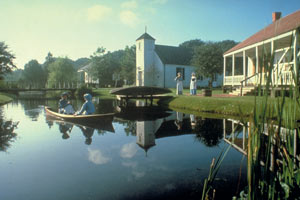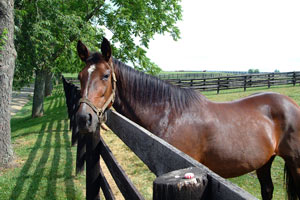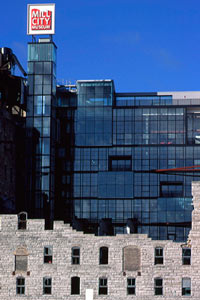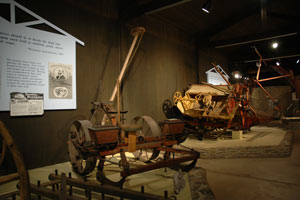A Ten-State Agri-Tour of Mississippi River Country
From its headwaters to the Gulf Coast, Mississippi River Country offers agricultural attractions and fascinating tours.
Join us as we travel the ten Mississippi River states from Minnesota to Louisiana on our tour of the heart of agricultural America. You’ll learn about cities built on single crops, the innovations of American farmers and hard-working settlers. Discover how technology changed not only farming practices, but the culture of rural life and the shape of American society today. The story of American agriculture highlights many of the nation’s greatest triumphs and struggles.
Let’s begin our agricultural tour of the ten Mississippi River states.
Louisiana
Southernmost of the Mississippi River States, Louisiana has relatively warm weather and a long growing season. The state is home to some of the oldest agricultural communities in the U.S. The perfect places to learn about southern rural life the LSU Rural Life Museum in Baton Rouge and Vermilionville in Lafayette.
LSU Rural Life Museum
4650 Essen Lane
Baton Rouge, LA
225-765-2437
Located on the 450-acre Burden Research Plantation, Rural Life provides insight into the largely forgotten lifestyles and cultures of pre-industrial Louisiana. Adjacent to the original Burden home, Windrush Gardens feature about 15 acres of semiformal gardens, with winding paths, lakes and open areas designed and planted by Steele Burden. The crape myrtles, azaleas, camellias and other plants are representative of flora in 19th-century plantation gardens.
Cajun and Creole culture permeates the Bayou region of southern Louisiana. Vermilionville is the perfect place to experience the distinct character of this rural region.
Vermilionville
300 Fisher Road
Lafayette, LA
1-866-992-2968
vermilionville.org

Vermillionville
Vermilionville authentically portrays a way of life preserved with a distinctly French accent. Situated on the banks of the Bayou Vermilion, this Cajun/Creole heritage and folklife park recreates life in the Acadiana area between 1765 and 1890. The beautiful grounds, which are laid out as an historic village, contain eighteen structures, including six restored original homes. In most of the structures, costumed interpreters demonstrate traditional crafts or musical styles. The facility also includes a full-service restaurant as well as a gift shop and art gallery filled with Cajun and Creole items, many of which are made by local artisans.
Mississippi
The State of Mississippi is home to a variety of landscapes, farming practices and crops. Poultry, lumber, catfish, cotton and soybeans are just a few of the products produced in Mississippi. Our next stop, the Mississippi Agricultural & Forestry Museum shows the history of agriculture and lumbering in the state.
Mississippi Agriculture & Forestry Museum
1150 Lakeland Drive
Jackson, MS
601-713-3365
mdac.state.ms.us/agmuseum/
Located in the heart of Jackson, the Mississippi Agricultural & Forestry Museum is an oasis of agriculture amid an urban landscape. The museum is made up of several different museums and exhibits, each focusing on a different aspect of Mississippi history. Exhibits include the Heritage Exhibit Center, the National Agricultural Aviation Museum, the Fitzgerald Collection, Small Town Mississippi, the Fortenberry-Parkman Farmstead, the Ethnic Heritage Center and the Forestry Auditorium. You’ll leave with a real sense of what rural life was like in Mississippi in centuries past and what it’s like today.
Bamboo Emu Farm
3280 Lakeview Golf Course Road
Meridian, MS
601-693-1108
Visit the largest working emu farm in the State of Mississippi. Learn about emu oil and its uses in pain relief and skin care products. Decorated emu eggs and emu meat are available. Call for a tour appointment.
Arkansas

Cotton Plantation
Cotton has been the most important crop in the history of Arkansas’s agriculture. Shaping both the culture, wealth-holding and land-ownership, following the story of cotton and its production is a great way to understand the history of the American South. Two Arkansas museums offer a fascinating glimpse into the world of 19th- and early 20th century farming.
Southern Tenant Farmers Museum
117 Main Street
Tyronza, AR
870-487-2909
stfm.astate.edu
The Southern Tenant Farmers Museum is home to photographic exhibits and artifacts focusing on the farm labor movement in the South and the tenant farming system of agriculture. During the early 1930s, the building housed the businesses of H.L. Mitchell and Clay East, two of the principal founders of the Southern Tenant Farmers’ Union (STFU). This national union, established July 13, 1934, in Tyronza by eleven whites and seven blacks, conducted much of its business at the building in which the museum is housed today. The STFU, which included women and blacks in leadership positions alongside white males, is regarded as a forerunner of the 1960s civil rights movement.
This site is also home to the Tyronza seasonal Farmers Market.
Plantation Agriculture Museum
U.S. 165 and Ark. 161
Scott, AR
501-961-1409
arkansasstateparks.com/plantationagriculturemuseum
A tour of the Plantation Agriculture Museum will reveal the world of farm life during the Plantation Era. Exhibits and programs interpret the history of cotton agriculture in Arkansas from statehood in 1836 through World War II, when agricultural practices quickly became mechanized. Visit the Dortch Gin Exhibit Building and learn how cotton was ginned. Guided tours are available for groups upon request—call for details.
Missouri
Missouri is where the West meets the Midwest. The state’s proximity to the grazing lands of the western United States made it an important center for cattle and livestock. A great place to learn about Kansas City’s role in the development of American agriculture is at the American Royal Museum.
American Royal Museum
1701 American Royal Court
Kansas City, MO
816-221-9800
americanroyal.com
The American Royal Museum is part of Kansas City’s famed barbecue, rodeo, horse and livestock show venue. Trained docents will lead you on a tour of this hands-on interactive museum of agricultural history. Gain insight into the vital role that agriculture played in Kansas City’s rich and storied history. Compare your weight with chickens, market hogs, and feeder steers. Try out the new equine exhibit and learn about different gaits. Tours are available by appointment.
Throughout Missouri, you’ll find a number of small independent farm operations. The relatively mild climate, varied landscape and good soil make Missouri a place where a wide variety of crops and livestock can be successful. Missouri farmers raise everything from wine grapes and berries to hogs and honey bees.
Tennessee
In the early 1800s, cotton rose to become the most important crop in the American South. Cotton was the fuel that ran nearly the entire economy. The rich soil of the newly planted lands and the invention of the cotton gin propelled the enormous growth of this crop. Tennessee was important both in the production and the distribution of cotton. Our next stop will be The Cotton Museum at the Memphis Cotton Exchange.
The Cotton Museum at the Memphis Cotton Exchange
65 Union Avenue
Memphis, TN
901-531-7826
memphiscottonmuseum.org
The Cotton Museum at the Memphis Cotton Exchange tells the story of the cotton industry and its many influences on daily life, the arts, and the development of this region. You’ll be able to traverse the “Members Only” trading floor of the Memphis Cotton Exchange, carefully restored to its 1939 glory—you’ll even see the 1939 prices hastily scribbled in chalk. The museum also features a 135-foot custom mural created by renowned Memphis artist David Mah. Freshwater pearls and the pearl button industry were once an important part of life along the Mississippi River. Today, the Tennessee River Freshwater Pearl Museum and Farm continues this legacy.
Tennessee River Freshwater Pearl Museum, Farm, Tour & Jewelry Showroom
255 Marina Road
Camden, TN
1-800-225-7469
tennesseeriverpearls.com
Witness a remarkable iridescent product of nature as it emerges from the indigenous Washboard mussel. Tennessee’s Official State Gem—the freshwater pearl—is rarely found naturally from these living animals, but grown at the only freshwater pearl-culturing farm operation on the North American continent. The organic gemstone-culturing operation is nestled in the pristine embayment of Birdsong Creek—just off the scenic Tennessee River’s beautiful Kentucky Lake—in Camden, nine miles north of Interstate 40 at Exit 133/Birdsong Exit. You’ll have a chance to take a three-hour guided tour of this working pearl farm. A catered barbecue luncheon is available for groups. The facility also includes a museum and jewelry showroom. Call to set up your tour.
Kentucky
The Bluegrass region of Kentucky is famous for its music as well as its world-champion horses and world-renowned bourbon. The best place on earth to learn about the world of horses and horse racing is the Kentucky Horse Park.
Kentucky Horse Park
4089 Iron Works Parkway
Lexington, KY
1-800-678-8813
kyhorsepark.com

Kentucky Horse Park
Kentucky Horse Park includes the world-renowned International Museum of the Horse, a joint venture with the Smithsonian Institution. You’ll also tour the American Saddlebred Museum, take a horse drawn tour and have a chance to view equine presentations throughout the day.
The Kentucky Horse Park also offers visitors a chance to take a behind-the-scenes tour of our world renowned Bluegrass horse farms. See working thoroughbred farms and equine-related facilities in the Lexington area—a truly unique experience. Contact the Kentucky Horse Park for more information about this opportunity.
Throughout the south, fish farming is an important industry. A fantastic place to learn about the fast-growing world of aquaculture is the Kentucky State University Aquaculture Research Center in Frankfort.
KSU Aquaculture Research Center
103 Athletic Road
Frankfort, KY
502-597-8104
ksuaquaculture.org
The goal of the KSU Aquaculture Research Program is to increase the knowledge-base in aquaculture, and thereby facilitate increases in farm income and the productivity of on-farm water resources in Kentucky and around the world. Call for more information and to schedule a tour.
Illinois

Credit: John Deere Pavillion
Illinois is famous for Chicago, its largest city. But a few minutes away from this metropolis, you will find a distinctly agricultural landscape. The farms and small towns of Illinois produced many of America’s most famous leaders, from Abraham Lincoln to Ronald Reagan. Much of Illinois industry is directly related to farming. Perhaps no name in agriculture is more famous than John Deere. Inventor of the first commercially successful steel plow, Deere went on to found one of the world’s largest corporations.
John Deere Pavilion
1400 River Drive
Moline, IL
309-765-1000
deere.com
The John Deere Pavilion features interactive agricultural exhibits. Learn about the history of agriculture and the equipment that has shaped its development. With the advent of new farm technologies and the significant improvements in agricultural science, farmers flourished on the fertile prairie lands of Illinois during the late 1800s.
Golden Historical Windmill and Museum
902 Prairie Mills Rd.
Golden, IL
217-696-2493
goldenwindmill.org
This museum gives you a chance to view an 1873 wind-powered grinding mill and see memorabilia of prairie life. It is the only restored, American-built windmill operating with its original millstones and wood gear mechanism. Weekday reservations are required.
Iowa
The fertile soils of Iowa are famous for their ability to support vast farms. While most people are aware of Iowa’s flatter side, the rolling hills and deep valleys of Iowa’s eastern along the Mississippi River provide some of the best scenery in the Midwest. It is a state that is full of surprises.
Amana Colonies Visitors Center
622 46th Avenue
Amana, IA
800-579-2294
amanacolonies.org

Amana Colonies Woolen Mill
One of the most fascinating destinations in Iowa is the Amana Colonies. It is composed of a series of closely knit villages built by a religious community known as the Inspirationalists. Discover these beautifully preserved farming communities, perhaps the most successful communal religious community in the history of U.S. The colonies are listed as a National Historic Landmark. You’ll find numerous museums, galleries and living history exhibits featuring authentic local handicrafts. An industrious spirit pervades the Amana Colonies—and all of Iowa, for that matter. The John Deere factory in Waterloo stands a testament to that spirit.
John Deere Waterloo Works Factory Tour
3500 East Donald Street
Waterloo, IA
1-800-765-9588
johndeere.com
Take a guided tour of the John Deere Waterloo Works, a massive manufacturing facility comprised of five different sites. The complex consists of more than 13.2 million square feet of office and manufacturing space. Observe the production of a full range of different tractors, from 95 to 450 horsepower. See the manufacture of engines, watch the assembly of the massive tractor drive trains and visit the unique gift shop. Tours happen twice a day on weekdays. Call ahead for times.
Wisconsin
Over the centuries, the varied landscape of Wisconsin supported a wide variety of agriculture. Native American’s planted corn and used controlled burns to cultivate native prairie grasses that helped to feed the herds of buffalo they depended on for food. Early European settlers brought many of their farming techniques from the Old World and applied them to this new landscape.
Wheat became a dominant crop in the mid-1800s. The widespread planting of wheat eventually lead to disease, which wiped out the wheat crop and threatened a serious economic collapse for Wisconsin’s farmers. Luckily, forward-thinking leaders, such as William Dempster Hoard, helped transform the state into one of the top dairy producing regions on earth. A great place to learn about Hoard and his incredible legacy is the Hoard Historical Museum in Fort Atkinson.
Hoard Historical Museum and National Dairy Shrine
401 Whitewater Ave
Fort Atkinson, WI
920-563-7769
hoardmuseum.org
Hoard Museum and National Dairy Shrine explores Fort Atkinson’s fascinating history and the story of Wisconsin. The National Dairy Shrine is a fun and educational blend of displays and exhibits that shed light on the development of the dairy industry and its importance to Wisconsin’s identity. The museum also includes exhibits about Abraham Lincoln and the Black Hawk War, which took place in this area. And you’ll find out about the area’s mysterious mound-building cultures dating back thousands of years.
The story of American agriculture is the story of America. For most of American history, the population tended to live in rural settings. The urban and suburban dominated culture we see today has only been a reality for the last 50 or 60 years. A great place to learn about the development of agriculture in the U.S. is Stonefield Historic Site near Cassville, Wisconsin.
Stonefield Historic Site
12195 Hwy VV
Cassville, WI
608-725-5210
stonefield.wisconsinhistory.org
Just steps from the entrance to Nelson Dewey State Park is the Stonefield Historic Site, managed by the Wisconsin Historical Society. Stonefield was the name of Governor Dewey’s farm. The Stonefield Historic Site is home to the State Agricultural Museum, where you’ll also see one of the most fascinating collections of tractors and other farm equipment ever assembled, including the first milking machine and the first tractor in North America, the “Auto-Mower” from 1896. It is one of the best places in the Midwest to learn about the history of agriculture in the U.S. and see the changes in agricultural technology.
Minnesota
To the immigrants coming to Minnesota in the late 1800s and early 1900s, the hills, prairies and woodlands of Minnesota seemed nearly endless. This enormous natural abundance helped to provide the growing U.S. with lumber, crops and mineral resources. Wheat, in particular, had an enormous impact on Minnesota’s economic and cultural development. The vast wheat fields of the Great Plains made Minneapolis the perfect center for the milling of grains. Minneapolis was once the world center for the production of flour, earning it the name “Mill City.”
Mill City Museum
704 South 2nd St.
Minneapolis, MN
612-341-7555
millcitymuseum.org

Mill City Museum
The Mill City Museum chronicles the flour milling industry that dominated world flour production for roughly a half-century and fueled the growth of Minneapolis. This award-winning museum is located within the ruins of the “Washburn A Mill,” a National Historic Landmark. The museum includes an eight-story “Flour Tower” and presents visitors with a multi-sensory, interactive journey telling the story of milling and its impact on Minneapolis, the nation and the world.
The wheat crops that built the metropolis of Minneapolis came from small farms located throughout the state. The Oliver H. Kelley Farm in Elk River is a great way to experience what it was like on one of these small farms.
Oliver H. Kelley Farm
Elk River, MN
763-441-6896
sites.mnhs.org/kelleyfarm
Located on US Hwy 10 and US Hwy 169, between Elk River and Anoka, you’ll find a timeless place. Take a step back to the 1860s at the Oliver H. Kelley Farm, set along the Mississippi River. Visitors will have a chance to help staff work in the fields using draft horses and oxen and join in seasonal tasks such as spring plowing and planting, summer cultivating and haying, fall harvesting, and year-long caring for farm animals. In the farmhouse, visitors can experience how technology changed everyday life in the 19th century, from using a “new” sewing machine to cooking on a wood stove. Nature trails on the site follow the Mississippi River through the 90 acres of wood and restored prairie.
The history center features a bookstore, videos and exhibits on Kelley and the Grange agricultural organization that he founded, and 1800s farming.
I hope you enjoyed this agricultural tour of the ten Mississippi River states. For more information on what this region has to offer group tours, browse this website.






